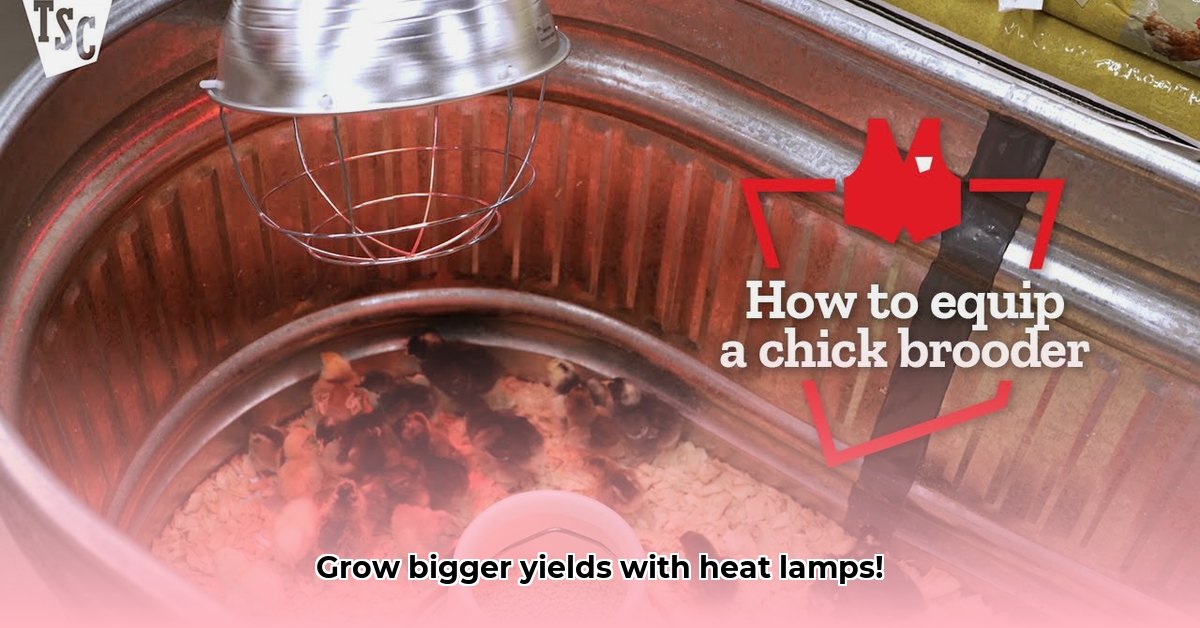
Keeping your livestock warm and your crops thriving, especially during colder months, is crucial for successful, sustainable farming. Heating lamps from Tractor Supply offer a versatile solution, but choosing and using them effectively and safely requires careful consideration. This guide provides a comprehensive overview, from selecting the right lamp to ensuring safe installation and practicing energy-conscious farming. For reliable power, consider battery chargers.
Types of Heating Lamps at Tractor Supply
Tractor Supply offers several heating lamp options, primarily infrared and red heat lamps. Each type presents unique advantages and drawbacks:
Infrared Lamps: These lamps efficiently generate heat directly, minimizing energy waste on warming the surrounding air. The gentle warmth is less disruptive to animals sensitive to bright light. (Include product photo from Tractor Supply). However, they might have a higher initial cost.
Red Heat Lamps: These lamps produce both heat and light, offering broader illumination. (Include product photo from Tractor Supply). While useful when supplemental lighting is needed or in larger areas, they are generally less energy-efficient than infrared lamps. The bright light may also disturb sensitive animals.
| Lamp Type | Pros | Cons | Best Suited For |
|---|---|---|---|
| Infrared | Energy-efficient; gentle warmth; less light pollution | Higher initial cost; may require higher wattage | Poultry, piglets, calves, reptile enclosures |
| Red Heat Bulbs | Cost-effective; comforting red light | Less energy-efficient; bright light may disturb animals | Seedlings, brooding chicks, small spaces |
Choosing the Right Heating Lamp
Selecting the appropriate wattage is critical for both effectiveness and energy efficiency. Higher wattage lamps heat larger areas but consume more electricity. Consider these factors when making your selection:
- Area Size: Larger spaces clearly require higher wattage lamps. Measure the area carefully before purchasing.
- Species: Different animals and plants have unique temperature requirements. Research ideal temperatures for your specific needs.
- Ambient Temperature: Colder climates will necessitate higher wattage lamps to maintain desired temperatures.
Don't hesitate to utilize Tractor Supply's website or in-store expertise for personalized recommendations. Remember, an oversized bulb wastes energy and money – choose wisely!
Safely Installing Your Heating Lamp: A Step-by-Step Guide
Safety is paramount. Incorrect installation can lead to fire hazards or electrical shocks. Follow these steps closely:
- Inspection: Before use, carefully inspect the bulb and cord for any damage. Never use a lamp with a damaged cord or cracked bulb.
- Appropriate Fixture: Use a sturdy fixture designed for the wattage of your chosen bulb. Cheap fixtures can overheat and create dangerous situations.
- Secure Mounting: Mount the fixture securely and away from flammable materials (hay, bedding, etc.). Keep it out of reach of animals.
- Ventilation: Ensure adequate ventilation around the lamp to prevent overheating. Trapped heat significantly increases fire risk.
- Power Down: Always disconnect the lamp before handling or replacing a bulb. Allow it to cool completely before touching to prevent burns.
- Grounding: Use a grounded three-pronged outlet for protection against electrical shocks. WARNING: Failure to use a grounded outlet increases the risk of serious injury.
Energy Efficiency and Sustainable Practices
While infrared lamps are generally more energy-efficient, mindful use is key to minimizing energy consumption. Consider these strategies:
- Targeted Placement: Strategically position lamps to maximize heat distribution and minimize wasted energy.
- Timers & Motion Sensors: Integrate timers or motion sensors to automate lamp operation, reducing unnecessary energy use. Timers can significantly reduce electricity costs.
- Improved Insulation: Enhancing insulation in your barn or greenhouse reduces energy loss and increases heating efficiency. This is a long-term investment with significant returns.
- Alternative Heat Sources: Explore supplemental or alternative heating methods such as solar panels or geothermal heating when feasible.
- Responsible Disposal: Dispose of old lamps responsibly through recycling programs. Check with Tractor Supply or your local waste management for options.
Maintenance and Troubleshooting
Regular maintenance ensures optimal lamp performance and extends lamp lifespan.
- Regular Cleaning: Dust accumulation reduces efficiency. Clean lamps periodically.
- Bulb Inspection: Regularly check bulbs for cracks or signs of wear. Replace promptly when needed.
- Wiring Inspection: Inspect cords and connections frequently for damage. Address any issues immediately.
- Tractor Supply Resources: Consult Tractor Supply's website or customer support for troubleshooting assistance.
Case Study: A Farmer's Success
A local farmer successfully used infrared heating lamps to brood chicks, reporting cost savings and healthy chick growth. His success emphasizes the importance of proper installation, choosing the right wattage, and responsible usage of heating lamps in sustainable farming practices.
Key Takeaways: Boosting Your Farm's Efficiency and Sustainability
- Choosing the right lamp dramatically impacts energy use and operational costs.
- Proper installation and regular maintenance are critical for safety and efficiency.
- Infrared lamps generally offer better energy efficiency compared to red heat lamps.
- Exploring alternative heating options can enhance sustainability.